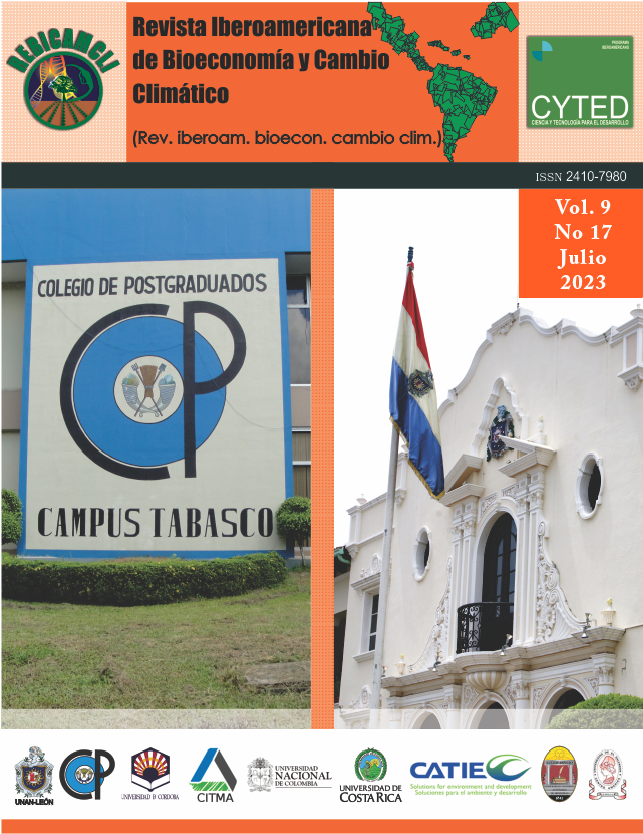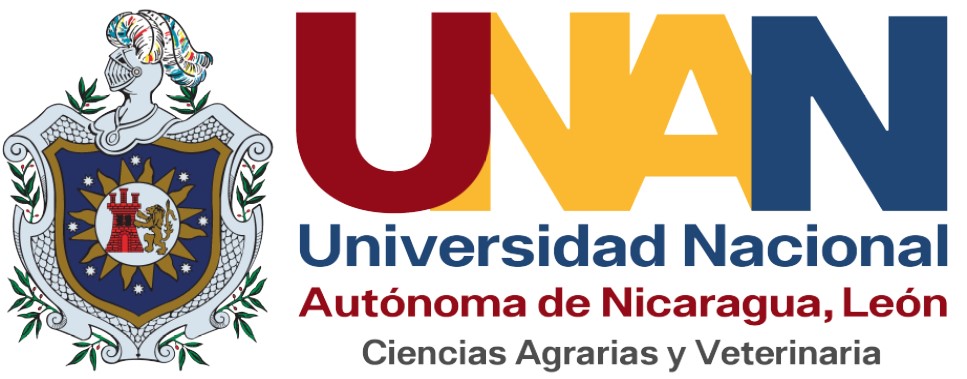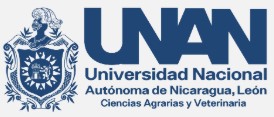Exploring Soil Exchangeable Cations and Auditing the Potential of Phoenix dactylifera and Mangifera indica in CO2 Sequestration into Soil Biomass in a Naturally ocurring tree patches
DOI:
https://doi.org/10.5377/ribcc.v9i17.16207Keywords:
Exchangeable Cations, tree-CO2 potential, CO2 Sequestration, Soil Biomass, Tree PatchesAbstract
Background: The experiment investigated soil Exchangeable Cations (EC) and audited the potential of Phoenix dactylifera and Mangifera indica in CO2 sequestration into soil biomass in other acts as remediating-factor for the sustainability of agriculture. Methodology: The study utilized a stratified sampling research design where Infrared Gas Analyzer (IRGA) was utilized to sample stratified locations within the experimental landmass for CO2 captured in the soil biomass within a five (5) month period. Sorensen’s Species Similarity Index was applied in the study to x-ray and validate the performance of the two tree species for CO2 sequestration potential similarity performance. Results: Results indicated that there exists a potential for the two tree species to sequester atmospheric CO2 at a value of 1.25± 0.13 and 0.47±0.19 for Phoenix dactylifera and Mangifera indica respectively at a five (5) monthly interval. Conclusions: The distribution of exchangeable cation of Ca2+, Mg2+, K+, and Na+ indicated that there exist an increase of the exchangeable cations in the soil solution at the end of the five (5) months with a Coefficient of Variation (CV=101%). An increase was observed in the Cation Exchange Capacity (CEC) of the soil from 7.3cmolkg-1 at the start of the experiment to 7.47 cmolkg-1 at the end of the experiment, indicating increased fertility status of the soils.
Downloads
Metrics
References
Adakayi P.E (2000). Drainage system of FCT. In P.D Dawam (ed) Geography of Abuja. Federal Capital Territory. Famous/ Asanlu Publishers, Minna.
Adiaha, M. S, Chude, V. O., Agba, O. A., Nwaka, G. I. C., and Oku, E. E. (2022). Mapping soil organic carbon-soil biodiversity variability in the ecosystem-nexus of tropical soils. EQA - International Journal of Environmental Quality, 50, 1–19. https://doi.org/10.6092/issn.2281-4485/14617 .
Adiaha, M. S., Buba, A. H., Tangban, E. E and Okpoho, A. N. (2020). Mitigating Global
Greenhouse Gas Emission: The Role of Trees as a Clean Mechanism for CO2 Sequestration. Journal of Agricultural Sciences - Sri Lanka,15: 1, 101-115 http://doi.org/10.4038/jas.v15i1.8675
Adiaha, M. S., Chude, V. O. ., Nwaka, G. I. C. and Oku, E. E. . (2022). Carbon auditing in tree-soil nexus: a sustainable approach towards CO2 sequestration and environmental transformation. EQA-International Journal of Environmental Quality, 48(1), 1–9. https://doi.org/10.6092/issn.2281-4485/13838
Adiaha, M. S., Oku, E. E., Chude, V. O., Nwaka, G. I. C., Ukem, B. (2019). Predicting soil erosion with estimation of saturated hydraulic conductivity from soil porosity: a strategy for meeting the SDG goal two and six. World Scientific News. 136, 194-225.
Adiaha, M. S (2022). Stimulation of tropical soils with Na+ Cl- ions and recovery of Na+ Cl- salinity using biochar and hydroleaching technology: a sustainable strategy for the management of saline and sodic soils under climate change. Rev. Iberoam. Bioecon. Climate Change , 8 (16), 1898–1928. https://doi.org/10.5377/ribcc.v8i16.15015
Armida, L.; Espinosa, V; Palma, D.; Galvis, A; Salgado, S. (2005). Carbon in microbial biomass and soluble carbon as quality indicators of vertisols cultivated with sugar cane. Terra Latinoamericana, 23(4), 545–551.
Beltran, F; Garcia, J.L; Valdez, R.; Murillo, B.; Troy, E; Larrinaga, J.A; Beltran, LF (2006). Effect of tillage systems and incorporation of green manure (Lablab purpureus) on soil respiration in a haplic Yermosol. http://www.redalyc.org/pdf/339/33911412 [Retrieved 14/1/2023]
Balogun, O. (2001).The federal capital territory of Nigeria: Geography of its Development. University of Ibadan; University of Ibadan Press. Nigeria.
Barahona Mejia, VD, Garmendia, YY, Villalta Pineda, KG, & Aguilar-Garcia, . YA (2022). Effects of Climate Change in Central America. Rev. Iberoam. Bioecon. Climate Change , 8 (16), 2018–2028. https://doi.org/10.5377/ribcc.v8i16.15227
Barahona Mejia, VD, Garmendia, YY, Villalta Pineda, KG, & Aguilar-Garcia, . YA (2022). Effects of Climate Change in Central America. Rev. Iberoam. Bioecon. Climate Change , 8 (16), 2018–2028. https://doi.org/10.5377/ribcc.v8i16.15227
Bhandari, A.L., J.K. Ladha, H. Pathak, A.T. Padre, D. Dawe, and R.K. Gupta. (2002). Yield and soil nutrient changes in a long-term rice–wheat rotation in India. Soil Sci. Soc. Am. J. 66:162–170.
Castilhos, D. D, Santos, V., Castilhos, R., Pauletto, E., Gomes, A., & Silva, D. ( 2004). Biomass, microbial activity and total carbon and nitrogen theories from one plane only under different management systems. Current Agricultural Science and Technology, 10(3).
CENTA (2002). National Center for Agricultural and Forestry Technology "Enrique Álvarez Córdova", El Salvador http://www.centa.gob.sv/html/ciencia/hortalizas/pipian.html [Assessed 14/1/2023]
Colque Arispe, K., & Ruiz-Alderete, D. (2019). Microbial biomass carbon influenced by the residues of five species of green manures on a soil under livestock use. Rev. Iberoam. Bioecon. Climate Change , 5 (10), 1267–1277. https://doi.org/10.5377/ribcc.v5i10.8967
Curti, D.S.A., Hernández, G.C., Loredo, S.X. (2012). Productivity of Persian lemon grafted on four rootstocks in a commercial orchard in Veracruz, Mexico. Revista Chapingo Horticulture Series 18(3): 291-305
Cochrane, T.T, and Barber, R.G (1993). Analysis of soils and tropical plants (No. 631.41 C659a). Tropical Agricultural Research Center.
Duarte, M.J., Pezo, D.A., Arze, J. (1994). Growth of three forage grasses established in an intercrop with corn (Zea mays L.) or vigna (Vigna unguiculata). Tropical Pastures. 16(1): 8-14.
Da Silva, XF A; Maia, SM F; de Oliveira, T. S; and de Sá Mendonça, E. (2006). Microbial biomass and mild organic matter alone on organic and conventional agricultural systems in Chapada da Ibiapaba-CE. Brazilian Journal of Soil Science, 30(2), 247-258.
Davidson EA, Savage K, Verchot L.V, Navarro R. (2002). Minimizing artifacts and biases in
chamber-based measurements of soil respiration. Agr Meteorol. 113:21-37.
https://doi.org/10.1016/S0168-1923(02)00100-4
Dehollain, P. L. (1995). Concept and conditions of food security in households. Food Magazine, 1(1), 4.
Dios-Palomares, R., Alcaide, D., Diz, J., Jurado, M., Guijarro, AP, Martinez Paz, J., & Zúniga González, CA (2015). Environmental aspects in efficiency analyses. Rev. Iberoam. Bioecon. Climate Change, 1 (1), 88–95. https://doi.org/10.5377/ribcc.v1i1.2143
FAO (Food and Agriculture Organization of the United Nations) (2016). A Framework for Land Evaluation. FAO Soils Bulletin 52, FAO, Rome, 79p. [Outlines the basic principles of the FAO approach to land evaluation and land use planning]. Italy, Rome.
FCDA, Federal Capital Territory (2000). The Master Plan For Abuja the New Federal Capital of Nigeria. Canadian International Development Agency.
Fernández, J.L, Benítez, D.E., Gómez, I., De Souza, A., Espinoza, R. (2004). Yield of dry matter and crude protein content of Panicum maximum vc likoni grass in vertisol soil of Granma province. Cuban Agricultural Magazine, 38(4): 417-422.
Frioni, L. (1990). Soil microbial ecology. Department of Publications and Editions of the University of the Republic, Montevideo, Uruguay. 519p
Giri, C., Ochieng, E., Tieszen, LL, Zhu, Z., Singh, A., Loveland, T., Masek, J., & Duke, N. (2010). Status and distribution of mangrove forests of the world using earth observation satellite data: Status and distributions of global mangroves. Global Ecology and Biogeography: A Journal of Macroecology, 20(1), 154–159. https://doi.org/10.1111/j.1466-8238.2010.00584.x
Granados, S. D, López-Ríos, G.F. (2002). Management of the coconut palm (Cocos nucifera L.) in Mexico. Chapingo. Magazine Forestry and Environmental Sciences Series. 8(1): 39-48.
Galantini, J.A, and Suñer. L. (2008). The organic fractions of the soil: analysis in the soils of Argentina. Agriscientia, 25(1): 41-55.
Gama-Rodrigues, AC, and Gama Rodrigues, EF (1999). Microbial biomass and nutrient cycling. Fundamentals of organic matter alone: tropical and subtropical ecosystems. Genesis Editions. Porto Alegre, Brazil, p 227-243.
Hazelton PA, Murphy BW (2007) Interpreting Soil Test Results: What Do All The Numbers Mean?. CSIRO Publishing: Melbourne.
Hernández ZRD, Flores CRJ, Isiordia AN, Robles BA, López MG, Sotelo M. A, M., (2017). Temperature and relative humidity in populations of phytophagous mites associated with lemon cultivation (Citrus lemon Burn) in Xalisco, Nayarit. Mexican Entomology 4:8-14.
Harrison, V. L. (1976). Do sunspot cycles affect crop yields? Economic Research Service, US Department of Agriculture. Agricultural Economic Report No. 327.
IDB (2016) Inter-American Development Bank (IDB). Flood Disaster Risk Profile for El Salvador / Inter-American Development Bank, p. cm. - (IDB Technical Note; 877). 157 p.
Iglesias, A. and Martin, FM (2009). Consequences of climate change for agriculture: a problem of today or of the future? Spanish Magazine of Agrosocial And Fishing Studies, (221), 45-70.
IPCC (2007). Climate Change (2007). Impacts, Adaptations and Vulnerability: Scientific-Technical Analyses: Contribution of Working Group II to the Second Assessment Report of the Intergovernmental Panel on Climate Change. Cambridge, UK, Cambridge University Press.
IPCC. (2000). Intergovernmental Panel on Climate Change. The Physical Science Basis. Contribution of Working Group I to the Fifth Assessment Report of the Intergovernmental Panel on Climate Change. https://doi.org/10.1017/cbo9781107415324.023
Isha Foundation Outreach (2021). 'How Trees Improve Soil Quality' by Rally for Rivers https://isha.sadhguru.org/rally-for-rivers/how-trees-improve-soil-quality/ [Retrieved 1/2/2023]
Ishaya, S. (2013). Flood Vulnerability Mapping in Gwagwalada Urban Area, Abuja, Nigeria. Unpublished Master’s Thesis, Department of Geography, University of Abuja, Nigeria.
Jarquín-Hernández, AA, Ortiz Rodríguez, CA, Rizo Blandón, MA, & José Emilio, GP (2019). Agroecological alternatives for fertilization in the cultivation of pipián (Cucurbita argyrosperma). Rev. Iberoam. Bioecon. Climate Change , 5 (9), 1129 1143. https://doi.org/10.5377/ribcc.v5i9.7949 .
Kekong, M. A., Ojikpong, T. O. and Attoe, E. E (2016). Influence of Moringa Leaf and Fertiplus on Soil pH and Garden egg yield in Obubra Rainforest Zone of Nigeria. Nigerian Journal of Soil Science, 26, 27-35.
Leguia H., Pietrarelli L., Luque. SM, Sánchez J., Alessandría E., Arborno M. and Zamar JL, (2004). The native forest as a reference for the deterioration of agricultural soils. Journal of Agroecology, 19(4): 28-31
Manna, M.C. Swarup, A., Wanjari, R.H., Ravankar, H.N., Mishra, B., Saha, M.N., Singh, Y.V., Sahi, D.K., Sarap, P.A. (2005). Long-term effect of fertilizer and manure application on soil organic carbon storage, soil quality and yield sustainability under sub-humid and semi-arid tropical India. Field Crops Research 93, 264–280.
Morales-Casco, LA, & Zúniga-González, CA (2016). Impacts of climate change on agriculture and food security. Rev. Iberoam. Bioecon. Climate Change , 2 (1), 269 291. https://doi.org/10.5377/ribcc.v2i1.5700
Nataren Velazquez, J., del Ángel Pérez, AL, Megchún-García, JV, Ramírez Herrera, E., & Meneses Márquez, I. (2020). Productive characterization of avocado (Persea americana Mill.) in the high mountain area of Veracruz, Mexico. Rev. Iberoam. Bioecon. Climate Change , 6 (12), 1406–1423. https://doi.org/10.5377/ribcc.v6i12.9941
Merchant, FM (2001). Microorganisms are only the dynamics of organic matter in grain and pasture production systems. Embrapa Agropecuária Oeste-Production System (INFOTECA-E).
Mercante, F.M, Silva, R.F.D., Francelino, C.S.F., Cavalheiro, J.C.T., and Otsubo, A.A. (2008). Microbial biomass, in a Argissolo Vermelho, in different vegetal coverages, in an area cultivated with cassava. Acta Scientiarum. Agronomy, 30(4), 479-485.
Muthanna, A. Al-Tameemi; Chukin V. (2016). Global weather cycle and solar activity variations. Journal of Atmospheric and Solar-Terrestrial Physics, 142 (2016) 55–59.
Matias, S.S.R., Aquino, B.F., Freitas, J.A.D., Camacho-Tamayo, J.H. (2008). Effect of NPK fertigation on the growth of the Verde de jiqui dwarf coconut palm. Bioagro. 20(3): 177-183.
Mercado R.G, (2016). The Bioeconomy-concept and application to rural development. Journal of Agricultural Research and Innovation and Natural Resources – RIIARn, 3(2): 188-193.
Nath, P. C., A. M. L. Arunachalam, K. Arunachalam, and A. R. Barbhuiya. (2005). Vegetation analysis and tree population structure of tropical wet evergreen forests in and around Namdapha National Park, northeast India. Biodiversity and Conservation, 14: 9, 2109–2135.
Paz R., Jara C., Nazar P., (2013). Social Economy and Family Farming. The experience of the Villa Río Hondo Fair (Argentina). Venezuelan Journal of Social Economy. 13(25): 53-74.
P. Sierra-Figueredo, O. Durán-Zarboso (2022) Agricultural yield in Cuba and its synchronism with Space Climate variables. Rev. Iberoam. Bioecon. Climate Change, 8 (15), 1822. https://doi.org/10.5377/ribcc.v8i15.14296
Page, A. L., Miller, R. H and Keeney, D. R. (1982). Methods of Soil Analysis Part 2. Chemical and Microbiological properties. American Society of Agronomy, Madison, Pp 55.
Rebolledo-Martínez, L., Megchún-García, JV, Rebolledo-Martínez, A., & Orozco-Corona, DM (2019). Association of Persian lemon (Citrus latifolia) and coconut palm (Cocos nucifera L.) fruit trees with the contribution of dry matter by annual crops. Rev. Iberoam. Bioecon. Climate Change , 5 (10), 1248–1266. https://doi.org/10.5377/ribcc.v5i10.8968
Rueda, V. O. M, and Garcia, C. G. (2002). Vulnerability and regional adaptation to climate change and its environmental, social and economic impacts. Ecological Gazette, (65), 7-23.
Sierra-Figueredo, P., Marinero-Orantes, E. A., Sol-Sanchez, A., & Zuniga-González, C. A. (2021). Variabilidad de la Producción Cafetalera en El Salvador y su Posible Relación con el Clima Espacial. Revista Iberoamericana De Bioeconomia Y Cambio Climatico, 7(14), 1632–1643. https://doi.org/10.5377/ribcc.v7i14.12607
Sierra-Figueredo, P., Marinero-Orantes, EA, Sol-Sánchez, Ángel, & Zúniga-Gonzalez, CA (2019). Cane sugar production in El Salvador and its relationship with the variability of Solar and Geomagnetic Activity: A Bioeconomy and Climate Change approach. Rev. Iberoam. Bioecon. Climate Change , 5 (10), 1209–1221. https://doi.org/10.5377/ribcc.v5i10.8946
Sol-Sánchez, A., Hernández-Melchor, GI ., and Hernández-Hernández, M. (2022). Bioeconomic development and mangroves in Latin America. Rev. Iberoam. Bioecon. Climate Change , 8 (16), 2007–2017. https://doi.org/10.5377/ribcc.v8i16.15162
Sol-Sanchez, A., Sierra-Figueredo, P., & Marinero-Orantes, EA (2017). Solar activity and its association with the rainfall regime in El Salvador. Rev. Iberoam. Bioecon. Climate Change , 3 (6), 782–799. https://doi.org/10.5377/ribcc.v3i6.5948
Sierra-Figueredo, P., Marinero-Orantes, EA, Sol-Sanchez, A., & Zuniga-González, CA (2021). Variability of Coffee Production in El Salvador and its Possible Relationship with Space Weather. Rev. Iberoam. Bioecon. Climate Change , 7 (14), 1632–1643. https://doi.org/10.5377/ribcc.v7i14.12607
Sørenson, T. A. (1948). method of establishing groups of equal amplitude on similarity of species content, Biologiske Skrifter K. Danske Videnskbernes Selskab, 5: 4, 1–34.
Suárez, De Castro (1960). "Relationships between rainfall and coffee production." Coffee, 2: 85-90.
Teixeira LAJ, Da Silva AA, (2003). Mineral nutrition of coqueiro populaces and hybrids (Cocos nucifera L.) cultivated in bebedouro (SP). Rev. Bras. Fruitic. Jaboticabal. Sp. 25(2): 371-374.
Toruño, PJ, Zuniga-Gonzalez, CA, Castellón, JD ., Hernández-Rueda, MJ, & Gutierrez-Espinoza, EI . (2022). Identification of the productive Paths of the Bioeconomy in CNU Universities and the agricultural sector. Rev. Iberoam. Bioecon. Climate Change , 8 (16), 1929–1946. https://doi.org/10.5377/ribcc.v8i16.15016
Tovar-Cabañas, R., Vazquez-Espinosa, SA ., & Villanueva-Hernández, H. (2022). Vulnerability, climate change and sea level rise in Boca del Río, Veracruz. Rev. Iberoam. Bioecon. Climate Change , 8 (16), 1929–1943. https://doi.org/10.5377/ribcc.v8i16.15042
Udo, E. J. Ibia, T. O., Ogunwale, J. O., Ano, A. O. and Esu, I. (2009). Manual of Soil, Plant and Water Analysis, Sibon Books Ltd. Lagos, Pp 183.
UNFCCC . (2000). Carbon dioxide control, Annul Report. http://www.unfcccreport2016 . [Retrieved 30/6/2019].
Vallejo, V. (2013). Importance and usefulness of the evaluation of soil quality through the microbial component: experiences in silvopastoral systems. Colombia Forestry, 16(1), 83–99.
Vázquez-Montenegro, RJ, Durán, O., & Baca M. (2014). Impact models in agriculture taking into account agricultural climate change scenarios. Ibero-American Journal of Bioeconomy and Climate Change.1(1), 1-50. https://doi.org/10.5377/ribcc.v1i1.2140
Wilding, L.G., (1985). Soil spatial variability: Its documentation, accommodation and implication to soil surveys. pp. 166-187.
Published
How to Cite
License
Copyright (c) 2023 Ibero-American Journal of Bioeconomy and Climate Change

This work is licensed under a Creative Commons Attribution-NonCommercial-ShareAlike 4.0 International License.
Copyright © 2025 Rev. iberoam. bioecon. climate change. National Autonomous University of Nicaragua León (UNAN-León), Knowledge Area of Agrarian and Veterinary Sciences / Specific Area of Agroecology and Agribusiness / Center for Research in Agrarian Sciencies. Academic Directorate. Research Department. Publication and scientific events Unit.












 EDITORIAL
EDITORIAL e-ISSN
e-ISSN


 COPYRIGHT
COPYRIGHT This work is licensed under a Licencia Internacional
This work is licensed under a Licencia Internacional 












